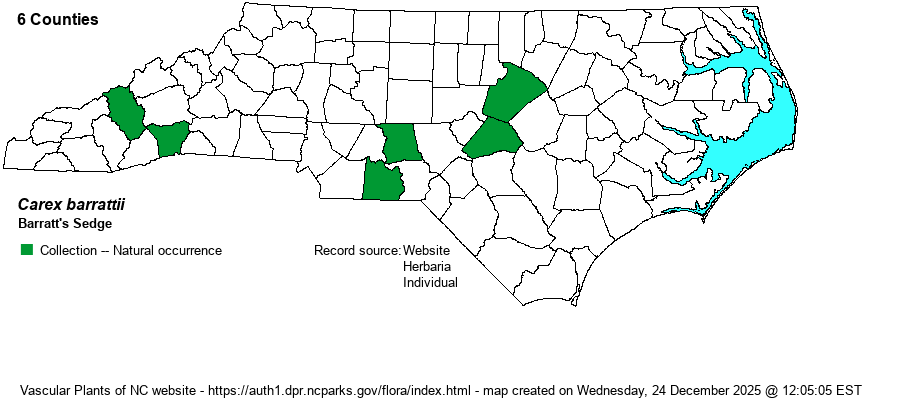| Author | Schweinitz & Torrey | |
| Distribution | Scattered in the Mountains (2 counties); disjunct to the lower Piedmont and inner Coastal Plain. Last collected in NC in 1957 in Harnett County and 1949 in Haywood County. In June of 2021 Eric Ungberg rediscovered Barratt's Sedge in the Uwharrie National Forest in Montgomery County, a very significant find for this rare sedge. Photos have been verified by Rob Naczi of NYBG; a specimen has been deposited at the UNC herbarium. In 2022 Becky Dill discovered a population at Pee Dee NWR in Anson County; a specimen has been deposited at NCU. In 2025 Alicia Jackson discovered two populations in a powerline on Fort Bragg in southern Harnett County; photos are verified and specimens have been taken.
CT and NY south to SC, TN, and AL. Most populations now are in NJ and DE; a quite rare and declining plant over most of this moderate-sized range. | |
| Abundance | Rare in NC, rediscovered in 2021. Known from just six records. It was listed as State Special Concern - Historical, but now should be listed as Special Concern - Vulnerable, if not State Endangered. The NCNHP moved the State Rank from SH to now S1. | |
| Habitat | The 2021 Montgomery County population occurs in a "hillside bog or boggy streamhead." The Anson County record is in a Piedmont Wet Flatwoods habitat. Both Anson and Montgomery populations occur with Iris prismatica. The 2025 Harnett populations occur with Danthonia epilis and Solidago verna. Other NC records are from "open bog" (Harnett County), "upland bog" (Henderson County), "margin of Cataloochee Creek" (Haywood County), and "swampy area along railroad" (Henderson County); no data for Wake County. In the VA Coastal Plain, habitats are "Depression swamps and ponds, boggy clearings, and peaty alluvial swamps" (Digital Atlas of the Virginia Flora website). |
| Phenology | Flowering and fruiting April-May. Weakley (2018) says "This species flowers and fruits rarely"; that is, within a population there will be far more vegetative plants than those with flowering culms. | |
| Identification | Except for the two Haywood County specimens (MIN, MO), all NC specimens have been annotated by Carex experts. It is identified by the dense yellow hairs on roots, glaucous or glaucescent culms and leaves, spikes on arching stalks, and female scales black or very dark brown with pale green midrib. Note also the elongate and relatively thick male spike. | |
| Taxonomic Comments | None
The genus Carex is the largest in North America, and among the largest in the world. In temperate and boreal regions, Carex is often the dominant or co-dominant ground layer in many habitats. Seeds (achenes) are valuable food for birds and small mammals, while foliage is used by birds and mammals to make nests and as food by mammals. Species of Carex often look vastly different from one another -- spikes erect vs. drooping, tiny inflorescence vs. whopping, culms leafy vs. naked, perigynia beaked vs. beakless, stems densely bunched vs. single, etc. The genus has been divided into many sections (or groups), based on shared characters; some taxonomists have suggested that these be different genera, but that proves unworkable (so far). All Carex share the feature of a perigynium (an outer covering) which completely surrounds the achene (seed). This covering may fit tightly or loosely (like a small bladder), depending on which group or species. Details of perigynia shape, ornamentation, presence and size of beak, number of striations (or veins) are all important ID features. In recent years Rob Naczi and colleagues have stressed the importance of arrangement of perigynia -- whether spiral (3+ ranks) or distichous (2-ranked) -- and have named a number of new species as well as split off some older synonyms. Therefore, RAB's (1968) key, excellent for its time, can only be used in a general way today. Members of some sections of Carex are difficult to key out (notably Ovales, Laxiflorae, Griseae); this is in part due to variation among individuals of a species, or failings of the key. FNA has drawings of most species and some species may be found in two or more places within a key, to acount for variability. New species to NC, and new to science(!), continue to be found in NC. | |
| Other Common Name(s) | None | |
| State Rank | S1 | |
| Global Rank | G4 | |
| State Status | SC-H [SC-V] | |
| US Status | | |
| USACE-agcp | OBL link |
| USACE-emp | OBL link |

